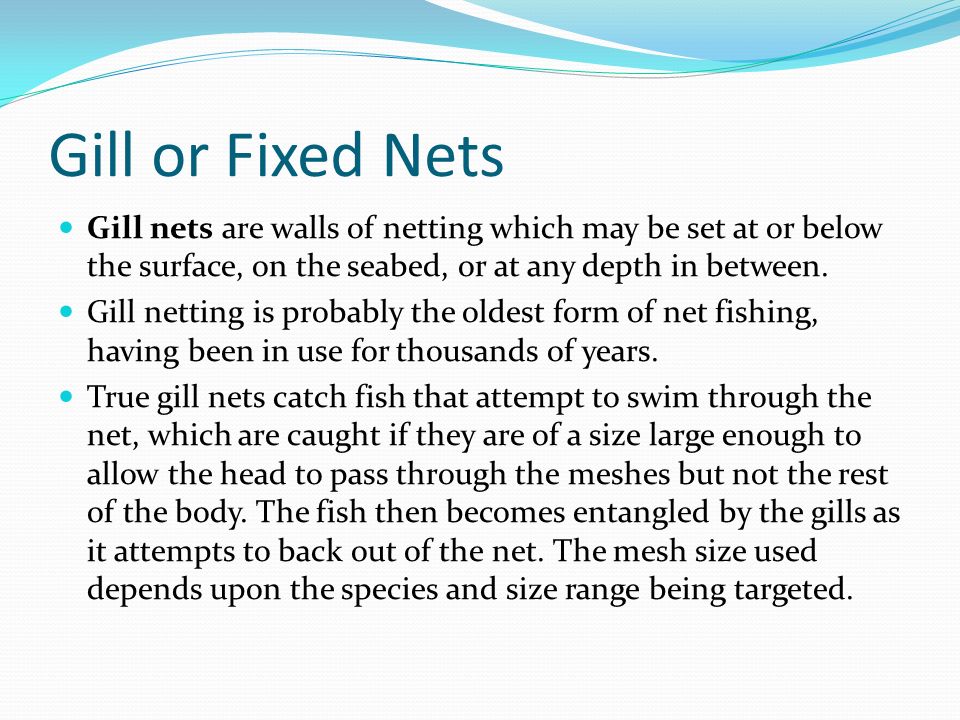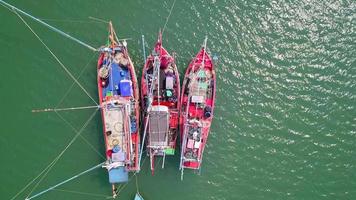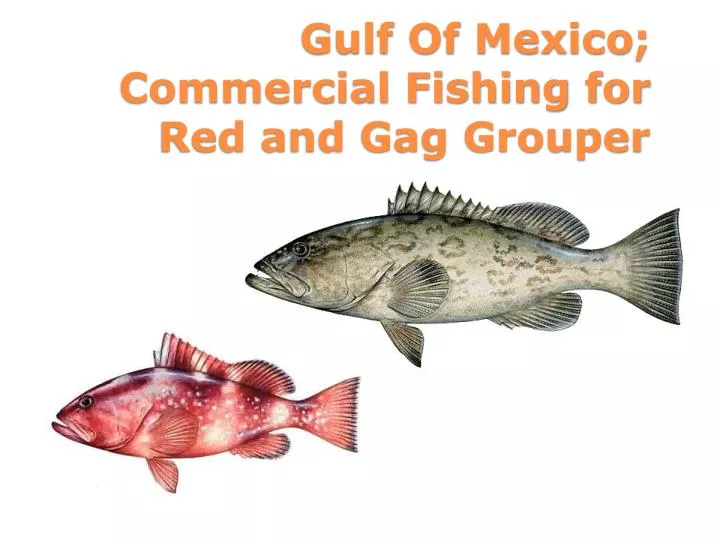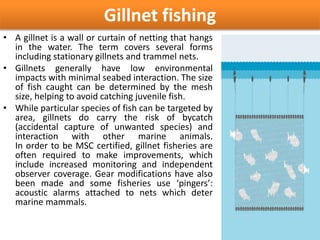Methods of Commercial Fishing - ppt video online download

Methods of Commercial Fishing
Depending on the depth of water fished and the way in which the gear is constructed and rigged, trawling may be used to catch different species. Trawls can be towed by one vessel using otter boards, as in bottom-trawling, or by two vessels, each towing one warp, as in pair-trawling. Or more than one trawl can be towed simultaneously as in multi-rig trawling. Trawling is a method of fishing that involves pulling a large fishing net through the water behind one or more boats. The net that is used for trawling is called a trawl.
In this type of trawl the mouth or opening of the net is kept open by a beam which is mounted at each end on guides or skids which travel along the seabed. These nets have ticklers that drag along the seabed in front of the net, disturbing the fish in the path of the trawl, causing them to rise from the seabed into the oncoming net. Electrified ticklers, may be less damaging to the seabed as they do not drag or dig into the sea floor. They are experimental at this time. Work is also being carried out to investigate whether square mesh panels fitted in the ‘belly’ or lower panel of the net can reduce the impact of beam trawling on communities living on or in the seabed. Modern beam trawls range in size from 4 to 12 m (weighing up to 7.5 tonnes in air) beam length, depending on the size and power of the operating vessel.
The forward part of the net – the ‘wings’ – is kept open laterally by otter boards or doors. Fish are herded between the boards and into the mouth of the trawl where they swim until exhausted. Insertion of square mesh panels also improves selectivity of the net because square meshes, unlike the traditional diamond shape meshes, do not close when the net is towed. Discarding of immature fish may also be reduced by increasing the basic mesh size in fishing nets. Sorting grids are must be set in nets in prawn and shrimp fisheries to reduce bycatch of unwanted or non-target species, including small prawns and shrimp.
When trawling takes place in the water column or in mid-water between the seabed and the surface, it is referred to as mid-water or pelagic trawling. Pelagic trawls target fish swimming, usually in shoals, in the water column i.e. pelagic species. These include seabass, mackerel, Alaska pollack, redfish, herring and pilchards for example. Their nets are larger than bottom trawls. In mid-water pair trawling vast nets, often ¼ mile wide and ½ mile long, are towed through the water column to capture the fish. Pelagic trawling affects marine mammals as they are caught accidentally when feeding on the same fish being targeted by fishermen; being unable to surface for air they eventually drown. Capture of marine mammals in fishing nets represents a very significant welfare problem. Animals can remain conscious for some time while struggling in the net, causing suffering and injuries such as lacerations and broken teeth and bones, before dying of suffocation.
A dredge is a metal framed basket with a bottom of connected iron rings or wire netting called a chain belly. The lower edge of the frame has a raking bar, with or without teeth, depending upon the species targeted. The catch is lifted off the seabed or out of the sea by the raking (or teeth) bar and passes back into the basket or bag. Depending on the size of the boat and the depth of water fished the number of dredges or ‘bags’ may vary from a single dredge towed behind the vessel to from 5 to 10 or more dredges per side. Dredges are generally attached to a towing bar and one is operated from each side of the vessel simultaneously.
Hydraulic dredges either use jets of water to disturb the ground in front of a towed dredge to capture bivalves, like razor clams and scallops, or use a pump to suck bottom sediments on board ship where bivalves are screened out and the spoil discharged back to sea. This methods removes a lot of the target species. It also disturbs the other bottom dwellers due to the silt and sediment that gets kicked up into the water.
Gill netting is probably the oldest form of net fishing, having been in use for thousands of years. True gill nets catch fish that attempt to swim through the net, which are caught if they are of a size large enough to allow the head to pass through the meshes but not the rest of the body. The fish then becomes entangled by the gills as it attempts to back out of the net. The mesh size used depends upon the species and size range being targeted.
Drift nets are not set or fixed in any way, are in fact ‘mobile’, and they are allowed to drift with the prevailing currents. They use gill nets that are allowed to drift with prevailing currents. Drift nets are used on the high seas for the capture of a wide range of fish including tuna, squid and shark, and salmon. Drift nets regularly ensnare sea mammals and reptiles, by-catch, is a frequent problem. An EU-wide ban on all drift nets was introduced from January
Tangle nets resemble gill nets but are slacker, shorter and have less flotation. This results in a looser-hung net that entangles species rather than gilling them.
An inner fine-meshed net is sandwiched between two outer, larger meshed nets. The net is anchored at the base and floated by the headline, allowing it to hang vertically. The inner net is looser than the outer ones, ensuring that the fish become entangled within it.
The net is then drawn together underneath the fish (pursed) so that they are completely surrounded. It is one of the most aggressive methods of fishing and aims to capture large, dense shoals of mobile fish such as tuna, mackerel and herring. Purse seining for yellowfin tuna used to use ‘dolphin-fishing’, where dolphins are deliberately encircled to trap the tuna swimming below them This is probably the most widely reported example of marine mammal by-catch. However, since the introduction of legislation to protect marine mammals in 1972 (Marine Mammal Protection Act) the number of yellowfin tuna taken in nets set deliberately on dolphins now only accounts for a very small proportion (3.3% in 1997) of tuna on the world market. Since their introduction in 1990 dolphin deaths in this area have been reduced by 98% to about 2-3,000 reported deaths per year.
This is a bottom fishing method and is of particular importance in the harvesting ground fish including cod, haddock and hake and flat-fish species such as plaice and flounder. The fish are surrounded by warps (rope) laid out on the seabed with a trawl shaped net at mid-length. As the warps are hauled in, the fish are herded into the path of the net and caught. Effectiveness is increased on soft sediment by the sand or mud cloud resulting from the warps’ movement across the seabed. This method of fishing is less fuel-intensive than trawling and produces a high quality catch, as the fish are not bumped along the bottom as with trawling.
Walls or compounds of netting are set out in a particular way and anchored to the seabed so that fish, once they have entered, are prevented from leaving the trap. In some cases, e.g. salmon traps, long leader nets are arranged from the shore to intercept migrating fish and guide them into the trap. Other species taken in traps include bass, herring and tuna. The selectivity of trap nets is determined by the mesh size used. Undersized or unwanted fish may be returned to the sea alive. However, in many tropical or subtropical fisheries where there is a large mix in species and size range, many fish are likely to become gilled as they attempt to escape from the trap. Seabirds and mammals are also prone to becoming entangled in the nets.
Although static gear such, as gill nets, generally have less impact on the environment than towed gears, they pose a particular problem for cetaceans (dolphins and porpoises). Methods to increase the ‘dolphin-friendliness’ of this fishing method include the attachment of acoustic devices or ‘pingers’ to the net to deter the animals; reducing the ‘soak time’,; i.e. the amount of time the net is left in the water; restrictions on the length of net used; and areas bans to keep fishermen from fishing in cetacean hot-spots .
They are widely used on continental shelves in all parts of the world for the capture of many species of crustaceans (crab & lobster) and fish, together with octopus and shellfish such as whelks. Potting is a highly selective method of fishing, since the catch is brought up alive, and sorting takes place immediately, allowing unwanted animals to be returned to the sea, making the method potentially sustainable. However, in Britain, fishing effort in the potting sector is high, with currently no restrictions on the number and type of pot used or the amount of shellfish taken. Pots used to be constructed from ‘withy’ or willow, but are now constructed from plastic-coated or galvanised wire with nylon netting. This makes them virtually indestructible. Modern pots or ‘parlour pots’ are also more complex and fitted with ‘pot-locks’, making escape impossible for the crab or lobster entering it. These factors combined with mechanical hauling allow fishermen to haul more pots and to leave them on the seabed for longer, thus increasing efficiency and fishing capacity.
It involves setting out a length of line, possibly as much as km long, to which short lengths of line, or snoods, carrying baited hooks are attached at intervals. The size of fish and the species caught is determined by hook size and the type of bait used. Although a selective method of catching fish, long-lining poses one of the greatest threats to seabirds. Species such as albatross, & shearwaters attack the baited hooks, get hooked, are dragged underwater and drowned. A range of practical measures have been developed to help prevent seabirds being hooked and drowned on long-lines. These include bird-scaring streamers that flap and scare birds away, setting lines at night when most albatross do not feed and weighting the line so it sinks quickly, bird scaring water cannons and setting the line nearer the water surface rather than over the side of the boat,thus minimising the lenght of time the bait is visible/available. Any of these measures will contribute to reducing seabird by-catch. Ask your supplier if the longline caught fish you buy has been caught using seabird-friendly methods.
Pole and line fishing (also known as bait boat fishing) is used to catch naturally schooling fish which can be attracted to the surface. It is particularly effective for tunas (skipjack and albacore). The method almost always involves the use of live bait (anchovies, sardines etc.) which is thrown over board to attract the target species near the boat (chumming). Poles and lines with barbless hooks are then used to hook the fish and bring them on board. Hydraulically operated rods or automatic angling machines may be used on larger pole and line vessels.
A jig is a type of grapnel, attached to a line, which may be manually or mechanically jerked in the water to snag the fish in its body. Jig fishing usually happens at night with the aid of light attraction.
The catch is of very high quality as the fish is usually live when brought aboard. Handlining is also a highly selective fishery in terms of species and size.
The method is particularly suited to the capture of pelagic species of high individual value. Examples include tuna (albacore and skipjack), barracuda and salmon.
Harpooning is a completely selective fishery, since the target must be seen before striking, so the size and hence age can be determined and only mature fish taken.
Dive-caught. Free diving (using mask and snorkel) or scuba diving is a traditional method of collecting lobster, abalone, seaweed, sponges and reef dwelling fish (groupers and snappers) for example. Species, including high value species such as giant clam, urchins, sea cucumber, lobster and scallops are now widely harvested by divers. Hand-collection by divers is potentially one of the most species selective and least damaging fishing method, provided harvesting is carried out responsibly.
Traditional methods of harvesting molluscs involve the use of hand tools such as tongs and rakes. Mechanical methods using hydraulic or suction dredges (see below) at high tide, or tractor harvesting at low tide, may also be used to harvest molluscs such as clams and cockles.
Some species of fish are often found with other living creatures (e.g. tuna are often found where dolphins and whale sharks are found) or objects floating or suspended in the sea. This natural phenomenon has been used to attract fish to floating or suspended structures. Such structures can provide known locations for finding fish. FADs may be used to concentrate fish in sufficiently high numbers which are then surrounded with a purse seine net. Fishermen using pole and line or trolling methods may use the boat from which they are fishing as a FAD.
Dynamite fishing. In some countries such as the Philippines, explosives (dynamite or blast fishing) are used on coral reefs to capture fish. Blast fishing is a particularly destructive method of fishing and is prohibited in many regions. A single explosion can destroy square metres of coral in the immediate area, whilst shock waves can kill fish in a radius of 50m or more from the blast. Reefs in some parts of South East Asia have been reduced to rubble in this way. Cyanide poisoning. Cyanide is used by fishermen in many areas of South East Asia, the Pacific and the Indian Ocean, to stun reef fish such as grouper and Napoleon wrasse which are then exported for the live reef fish food market or aquarium trade. Although its use is prohibited the practice continues because of the demand for certain species (e.g. Napoleon wrasse) as gourmet delicacies.
Industrial Fishing targets species that we use for parts (e.g. the manufacture of fish oil and meal). It does not refer to the fisheries that collect fish intended for humans to eat. Fish meal and oil is produced almost exclusively from small, pelagic species, for which there is little or no demand for direct human consumption. The methods of capture are purse-seining and trawling with small mesh nets in the range of mm. Fish oil is used in a range of products including margarine and biscuits. Fish meal and oil has more widespread use, however, in the manufacture of pelleted feedstuffs for intensively farmed poultry, pigs and, not least, aquaculture. One of the main impacts associated with industrial fishing is the removal of large quantities of species from the base of the food chain.
Aquaculture is a term used to describe the farming of marine and freshwater organisms. Mariculture only refers to the farming of marine organisms; it can be further defined as: open mariculture (or semi-culture) where organisms are farmed in a natural environment, such as mussels, closed mariculture (or intensive mariculture) where organisms are farmed in closed environments.
Fish that are commonly grown in cages include Atlantic salmon in Europe and America; Pacific salmon in America; the yellowtail in Japan; and seabass and groupers in Greece, Malaysia and Indonesia. In Britain, two species of fish are principally farmed: Atlantic salmon in salt- water and rainbow trout in fresh water. This is changing with the introduction of farming of new marine species such as cod, haddock and halibut. The major growth sector in UK mariculture is farmed Atlantic salmon.
Whilst fish farming relieves pressure from exploitation of wild stocks and could be managed in a sensitive and sustainable way, the scale of most modern fish farming in the UK has led to environmental impacts that negate any overall environmental gain. One of the biggest impacts of fish farming on the marine environment is the production of fishmeal used to feed farmed fish. The protein for this fishmeal is sourced from small pelagic fish that are not targeted for human consumption, but form the base of the food chain and are important prey for other species such as cod.
v=BA7enHKa5As. v=9_-BdqS54q8&feature=channel. v=wJSMGFAxpEs.
v=O_OJ18NRKKk&feature=related. v=vbRQRAMUYKQ&feature=related.

Fishing Industry Stock Video Footage for Free Download

Fisheries Fishing Methods. - ppt video online download

Fisheries in India: Conservation, Laws & Regulations - Lesson

Fishing Infographics Google Slides & PowerPoint
Commercial fishing methods : an introduction to vessels and gears : Sainsbury, John C. (John Charles) : Free Download, Borrow, and Streaming : Internet Archive

Commercial fishing methods - Sustainable Fisheries UW

PPT - Gulf Of Mexico; Commercial Fishing for Red and Gag Grouper PowerPoint Presentation - ID:6685114

Sustainable Fishing

Fishing Infographics Google Slides & PowerPoint

Fisheries Fishing Methods. - ppt video online download

Methods of Commercial Fishing - ppt video online download

Fisheries Slide Presentation
Commercial fishing methods : an introduction to vessels and gears : Sainsbury, John C. (John Charles) : Free Download, Borrow, and Streaming : Internet Archive

Destructive and prohibited fishing practices